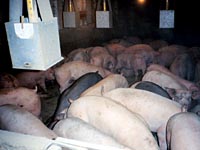
Desirable carcasses are those which bring the highest price with the lowest possible input. This is achieved by using high quality genetic stock supporting traits for rapid lean growth, and by selecting a slaughter time which optimizes carcass yield. Government regulations and meat inspections programs are the basis for premiums paid to producers which meet or exceed high quality standards.
Carcass grades are based on ultrasound measurements for backfat and loin eye thickness taken at 7 cm off the midline between the 3rd and 4th last ribs. Prediction equations are used to estimate the carcass yield percentage. Using the predicted carcass yield percentage and the animals weight, and index value is assigned.
| Canadian Hog Carcass Grades (National) |
| |
Weight Class (kg) |
Yield Class
Percentage |
40-
64.99 |
65-
69.99 |
70-
74.99 |
75-
79.99 |
80-
84.99 |
85-
89.99 |
90-
94.99 |
95-
99.99 |
100+ |
| > 53.6 |
80 |
100 |
110 |
114 |
114 |
112 |
107 |
101 |
81 |
| 52.0-53.59 |
80 |
96 |
107 |
112 |
112 |
110 |
104 |
97 |
81 |
| 50.4-51.99 |
80 |
92 |
104 |
109 |
109 |
108 |
100 |
93 |
81 |
| 48.8-50.39 |
80 |
88 |
102 |
107 |
107 |
105 |
96 |
89 |
81 |
| 47.2-48.79 |
80 |
85 |
100 |
104 |
104 |
101 |
92 |
82 |
81 |
| 45.6-47.19 |
80 |
83 |
96 |
100 |
100 |
97 |
88 |
82 |
81 |
| < 45.6 |
80 |
82 |
90 |
96 |
96 |
94 |
82 |
82 |
81 |
Animals assigned an index value of 110 would be paid a 10% premium over the stated market price. Animals assigned an index value of 96 would be paid at a 2% discount. Carcasses may also be discounted for poor quality meat. Most carcasses are values between 95-110. | 